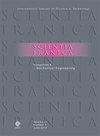Minimum stiffness and optimal position of intermediate elastic support to maximize the fundamental frequency of a vibrating Timoshenko beam
IF 1.9
4区 工程技术
Q2 ENGINEERING, MULTIDISCIPLINARY
引用次数: 0
Abstract
: The optimal position and minimum support stiffness of a vibrating Timoshenko beam are investigated to maximize the fundamental frequency. The Finite element method is employed. According to the maximum-minimum theorem of Courant, the optimum position is at the zero of the second mode shape function. The intermediate support's position and minimal stiffness for a wide variety of slenderness proportions were achieved. It was observed that the ideal position of intermediate support and its minimum stiffness are sensitive to the slenderness ratio. Also, for thick cantilever beams with intermediate support at the optimal location, the minimum support stiffness is less than 266.9, which was reported in the literature for the Euler-Bernoulli beam. The minimum stiffness of familiar end conditions of an optimally located beam is presented for a wide range of slenderness ratios. Since, in many practical applications, it is impossible to locate support at the optimal position, the minimum support stiffness for a beam in which its intermediate support is not located at the optimal position is obtained for various boundary conditions and slenderness ratios. Furthermore, empirical evaluations were carried out, and the findings were contrasted with hypothetical estimates of the initial two natural frequencies.最小刚度和中间弹性支撑的最佳位置,以最大限度地提高振动Timoshenko梁的基频
为使基频最大化,研究了振动Timoshenko梁的最佳位置和最小支承刚度。采用有限元法。根据Courant的极大极小定理,最佳位置在第二模态振型函数的零点处。实现了各种长细比的中间支撑位置和最小刚度。结果表明,中间支承的理想位置和最小刚度对长细比较为敏感。对于最优位置有中间支承的厚悬臂梁,最小支承刚度小于266.9,这在Euler-Bernoulli梁中有文献报道。在较宽的长细比范围内,给出了最佳定位梁的最小刚度。由于在许多实际应用中,不可能将支座定位在最优位置,因此在各种边界条件和长细比下,求得中间支座不在最优位置的梁的最小支承刚度。此外,还进行了实证评估,并将结果与初始两个固有频率的假设估计值进行了对比。
本文章由计算机程序翻译,如有差异,请以英文原文为准。
求助全文
约1分钟内获得全文
求助全文
来源期刊

Scientia Iranica
工程技术-工程:综合
CiteScore
2.90
自引率
7.10%
发文量
59
审稿时长
2 months
期刊介绍:
The objectives of Scientia Iranica are two-fold. The first is to provide a forum for the presentation of original works by scientists and engineers from around the world. The second is to open an effective channel to enhance the level of communication between scientists and engineers and the exchange of state-of-the-art research and ideas.
The scope of the journal is broad and multidisciplinary in technical sciences and engineering. It encompasses theoretical and experimental research. Specific areas include but not limited to chemistry, chemical engineering, civil engineering, control and computer engineering, electrical engineering, material, manufacturing and industrial management, mathematics, mechanical engineering, nuclear engineering, petroleum engineering, physics, nanotechnology.
 求助内容:
求助内容: 应助结果提醒方式:
应助结果提醒方式:


